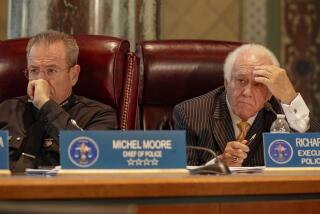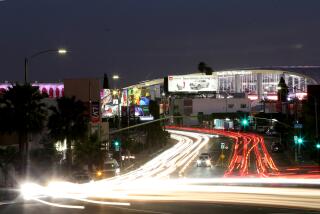Safety Hopes in Inglewood Rest on Curfew
A chill hangs in the midnight air--a chill of the mind as much as the mercury--as teen-agers begin pouring from the hall after Inglewood High School’s spring break dance.
Quietly but conspicuously, half a dozen armed school police officers fan out, keeping watch, as the students laugh, chat and huddle in knots along Manchester Boulevard, a busy thoroughfare that leads to South-Central Los Angeles one way and the coastal enclaves of Westchester and Playa del Rey the other.
With one of the highest crime rates in Los Angeles County and still aching from the killing of a toddler, a cheerleader and nine others gunned down in a record weekend of bloodshed earlier this year, Inglewood experiences no small uneasiness when young people are out at night and vulnerable.
“The gangs, the shootings. They keep you on pins and needles,” said parent Tongia Johnson, who arrived before the dance ended and parked just outside the hall door to collect her 15-year-old daughter. “You’re scared about (your children) all the time.”
“You don’t know who’s gonna walk up behind you and just start shooting,” 15-year-old Patrice Taylor said as she waited for a ride with a group of friends.
Not surprisingly, many parents such as Johnson--and even a fair share of teen-agers--have welcomed Inglewood’s aggressive revival of a simple, seldom-used law enforcement tool: the juvenile curfew law.
A growing number of cities--Norwalk, Long Beach and Santa Monica--have turned to juvenile curfews in recent years to help stem street crime. But Inglewood’s new, highly organized system of weekend sweeps, which is drawing critical attention from the American Civil Liberties Union, is among the toughest and most ambitious of the new wave of enforcement efforts. The curfew has been in effect since March 18.
And it appears to have extended a special sense of hope to a community where the police chief, who was shot at by a would-be robber one night last year, has urged residents to remain home after dark.
“At least they’re thinking about (us),” said Patrice King, an Inglewood High senior. “I’m thankful that people do care.”
The Friday and Saturday night sweeps begin at 11 and target anyone under 18 who is on the streets without a legitimate reason, such as returning from work or a dance or running an errand with a parent’s permission. The curfew is 10 on weeknights, although the special enforcement program is concentrated on the weekends, when the most shootings occur.
Roving vans and a cadre of reserve police officers, backed by community volunteers who handle paperwork at the station, rounded up more than four dozen youths in the first three weekends, among them an 11-year-old boy, several young girls and a 17-year-old robbery suspect.
In one particularly disturbing apprehension, officers who approached a beer-drinking 17-year-old found an AK-47 assault rifle. In the teen-ager’s pocket was a fully loaded 30-round ammunition magazine.
The mix of youths picked up so far underscores part of the rationale for resuscitating a neglected program that some may view as faintly anachronistic on today’s streets. As much as nabbing potentially violent teen-agers, officials say they are trying to remove young targets from the gangbangers’ cross-fire.
“I want young people off the streets,” Police Chief Oliver Thompson said. “If I have them off the street, they are not likely to be victims of crime or perpetrators of the crime.”
One aim of the program is to prod parents into accepting more responsibility for their children. Parents must collect their children at the police station, and later accompany the young violator to juvenile court, where penalties can range from community service work to fines of up to $675.
No one is touting the curfew crackdown as a panacea for crime problems in this predominantly minority bedroom community of 113,000, which last year averaged a homicide every eight days; nearly half of them were attributed to gang violence.
“This is only one step,” said Councilman Jose Fernandez, a 34-year-old high school teacher who grew up in the city and pushed the curfew program. “It’s creating a climate of order . . . setting guidelines and rules. There is a (public) pessimism that needs to be changed. People feel there is no hope; there will be no change.”
Inglewood officials are pleased with the anecdotal results of the program, but there is scant research on what long-term changes occur when juvenile curfew programs are strictly enforced, criminologists say. Some law enforcement officials view them as political reactions with dubious value, and some street officers complain that curfew programs can bog them down in baby-sitting of wayward youths.
“When I first made the announcement (at an officer roll call), everybody rolled their eyes,” Inglewood Lt. Alex Perez said. But by most accounts, including those of police association representatives, officers for now are supporting the effort.
Some curfew programs have succumbed to cost considerations and higher-priority law enforcement tasks. Inglewood officials insist that they are committed to sustaining strong curfew enforcement, although just how that will be accomplished remains vague. Officials have been relying heavily on unpaid reserve officers and community volunteers to carry the program, and it is uncertain how long they can do that.
Even if city officials can figure out ways to maintain the program, it could face a legal challenge. A spokeswoman for the ACLU of Southern California says attorneys are reviewing Inglewood’s enforcement of the juvenile curfew for possible constitutional violations.
On the streets, there is no shortage of critics among Inglewood teen-agers and young adults, from student leaders to gang members.
At Rogers Park near the heart of the city--the territory of the Neighborhood Pirus or NHP gang--some scoffed at the curfew.
“You’re still gonna see 16- and 17-year-olds running out here. The majority of the people doing all (the shootings) are 16 and 17,” said “Kilo,” who pointedly showed a huge abdominal scar that he said he received in a shooting near the park last year. If the curfew is rigidly enforced, he warned, it would exacerbate volatile relationships many teen-agers have with their parents. “I think it could cause more violence at home,” he said.
“Scooby,” wearing an “NHP” cap, conceded that it may be a good idea to get young people off the streets at night, but he noted that many gang members will not be affected. “I’m over 18. They can’t do nothing to me,” he said.
At Inglewood High, UC Irvine-bound Erin Bryant, 17, secretary-treasurer of her class, was skeptical for different reasons. “It’s a temporary solution to a permanent problem. It was proposed to reduce the level of youth violence . . . however, things can occur whether its night or day.”
In fact, of the 11 shootings on that gruesome January weekend, the five fatalities occurred between 7 and 8:30 p.m.
But at least as many young people voice support for the curfew program, or at least grudgingly acknowledged that it is having the desired effect. “In a way, it helps,” said a 17-year-old from the Hyde Park area, who dryly described being nabbed in the sweeps while hanging out in front of a friend’s house around midnight. Now, his mother makes him come home by 9 on most nights.
For some teen-agers, the curfew actually seems to have enhanced their freedom to go out and socialize, interviews show.
“That’s one reason I let her come tonight,” said Bernard Webster, a maintenance worker who was waiting to collect his 14-year-old daughter at the high school dance. “I (was) reluctant. . . . (But) I feel safer. I think it will cut out a lot of drive-by shootings.”
Ironically, the curfew comes as Inglewood’s crime rate--including gang-related incidents--has declined from peaks of a few years ago. But officials say homicides remain unacceptably high--well above levels of a decade or so ago--and the horrifying violence of some recent incidents has left many residents terrified.
Indeed, the curfew program grew from community complaints and is part of the city’s push into community-oriented, problem-solving policing, officials say. “It’s one of the things people first talked to me about: ‘Why aren’t all these kids off the street?’ ” said Thompson, who came to the city two years ago from the Riverside Sheriff’s Department.
Previous initiatives have included expanded Neighborhood Watch programs, basing police officers at public schools and offering a police-supervised program of midnight basketball games, designed in part to get older gang members and young adults off the streets.
Among other things, officials hope the curfew will signal a new seriousness about crime control in a city that attracts tens of thousands of visitors each year to the Forum and Hollywood Park, which soon will open a large card club casino.
Inglewood, more than most cities in the county, has felt the strain of the region’s growth and ethnic change. It went through wrenching years of conflict and massive white flight in the 1960s and early 1970s, partly the result of one of the state’s first court-ordered, cross-town school busing programs. In the same period, charming neighborhoods suffered from increased jet noise as nearby Los Angeles International Airport grew. And the once-strong central business district, which drew from a large southern area of the county, declined as malls proliferated in nearby cities.
In that context, some see the experiment with the tough new curfew program as a sort of benchmark--symbolizing a new determination by residents and businesses to reclaim their city.
At a block club meeting on 8th Place last week, residents praised the curfew program and complained sternly that troublemakers’ parents must be held accountable.
“We’re trying to save these kids,” Police Department spokesman Ruben Taylor told residents gathered in Gussie Collins’ living room. “We’re losing too many young black and brown men.
“This is an attempt. A beginning. A start to try to gain control of our community,” he said as residents nodded. “These are our children. This is our community.”
Timely Measures
A growing number of cities are reviving enforcement of juvenile curfew laws to combat street crime and reduce the number of young victims of random violence. Generally, the programs make exceptions for juveniles traveling for work, bona fide events or on approved errands for parents. Here are some of the recent experiments:
* Norwalk: Four-year-old program includes two specially supervised mobile mini-stations which can be deployed to juvenile trouble spots. Patrol officers drop off juveniles found on streets after 10 p.m. Parents are contacted, citations issued and community service ordered as penalty. Averaging about 20 violators per week. Officials say it has reduced gang activity and drive-by shootings.
* Phoenix: Two-year-old program runs seven days a week and is a model for some other cities. Curfew is 10 p.m. for youths 15 and under, midnight for 16- and 17-year-olds. Violators are cited and taken to centers staffed by police and recreation workers, where they can watch TV or play sports until parents arrive. Violent crime involving older teen-agers was down last year, but such crime was up slightly among younger ones. Legal challenge by American Civil Liberties Union now in state appeals court.
* Long Beach: Three-month-old program similar to that in Phoenix. Curfew is 10 p.m. and enforced by regular patrol officers. Violators are cited and may be released or taken to recreation centers or police stations, where they are supervised by officers until parents arrive. About 20 juveniles a week receive citations.
* Santa Monica: Ordinance adopted last year sets curfew at 10 p.m. weekdays and 11 p.m. Friday and Saturday. Typically, police issue a warning, but occasionally issue citations or contact parents. About 15 curfew “contacts” a month are made with juveniles.
More to Read
Sign up for Essential California
The most important California stories and recommendations in your inbox every morning.
You may occasionally receive promotional content from the Los Angeles Times.










